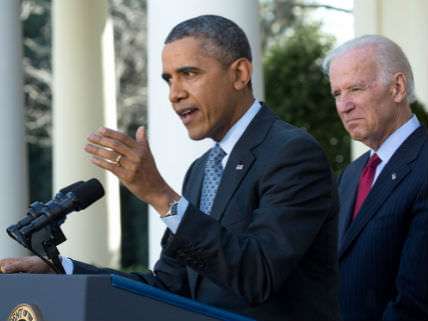New York Times Exaggerates the Number of Americans Newly Covered by Obamacare Subsidies and Medicaid Expansion

In a story about House Budget Committee Chairman Paul Ryan's latest 10-year spending plan, New York Times reporter Jonathan Weisman says the Wisconsin Republican proposes "total repeal of the Affordable Care Act just as millions are reaping the benefits of the law," a juxtaposition that sounds like a Democratic talking point. Later Weisman claims "more than 10 million Americans have gotten health insurance through the law, either through private policies purchased on insurance exchanges, through expanded Medicaid or private policies purchased through brokers but subsidized by the law."
That estimate apparently includes the 7 miillion or so people who have picked out plans on the federal or state exchanges, not all of whom actually have "gotten health insurance," which requires paying the first premium. At this point we do not know how many of the 7 million have taken that step. Furthermore, we do not know how many are newly covered and how many were previously insured but switched to the exchanges, perhaps because their old policies were canceled as a result of Obamacare's minimum coverage requirements. Hence it is quite misleading to say that all 7 million "have gotten health insurance through the law," which implies that they would have been uninsured but for the law.
Weisman would have been aware of these two issues if he kept abreast of my colleague Peter Suderman's insightful Obamacare coverage—or if he had read the work of his own colleagues. In a story on the front page of today's Times, Michael Shear and Robert Pear note:
Several of the most ardent critics of the health care law expressed doubt about the official tally of sign-ups, noting that the White House had not released information about how many people who signed up had paid their initial premiums.
The critics also noted that an unknown number of people who signed up at HealthCare.gov had previously been insured under plans that were canceled. White House officials said they did not yet have a tally of that category.
How big a difference might these two factors make? Pretty big. In a recent Forbes post, Avik Roy cites surveys by McKinsey and the RAND Corporation indicating that between one-quarter and one-third of exchange enrollees were previously uninsured. According to the McKinsey survey, only 53 percent of previously uninsured enrollees had paid their first premiums. Taken together, these findings suggest that the number of previously uninsured people who have obtained coverage through the exchanges may be closer to 1 million than 7 million.
Weisman says he is also counting people who obtained coverage "through expanded Medicaid." According to a recent tally by Los Angeles Times health care reporter Noam Levey, the RAND survey (which has not been published yet) indicates that "at least 4.5 million previously uninsured adults have signed up for state Medicaid programs." Even if all of those people were previously ineligible, we are still more than 4 million shy of Weisman's "more than 10 million" claim.
What about people newly covered by "private policies purchased through brokers but subsidized by the law"? According to RAND's survey, Levey reports, "about 9 million people have bought health plans directly from insurers," but "the vast majority of these people were previously insured." Levey also notes that, according to data from the U.S. Centers for Disease Control and Prevention, "an additional 3 million young adults have gained coverage in recent years through a provision of the law that enables dependent children to remain on their parents' health plans until they turn 26." But Weisman's description of his estimate does not include those people.
Eric Boehlert of Media Matters for America does include the 3 million adults newly covered by their parents' plans but, like Weisman, erroneously counts all 7 million exchange enrollees. Put those two numbers together, Boehlert says, and you can see that "more than 10 million people have used Obamacare to secure health coverage." Well, not quite. CBS News plays it safer, saying "it's possible that more than 10 million people have insurance thanks to Obamacare," counting the changes to Medicaid and family plans as well as insurance bought through exchanges. Levey says "at least 9.5 million previously uninsured people have gained coverage." He assumes that one-third of exchange enrollees were previously uninsured (as indicated by the RAND survey) but does not consider how many have paid their first premiums.
One point none of these estimates seems to consider is that some previously uninsured people would have obtained coverage even without Obamacare. We do not know, for example, how many 25-year-olds would have bought their own health insurance or obtained it through work had they not been covered by their parents' plans. Even some of the people newly eligible for Medicaid might have found jobs with health benefits and therefore obtained medical coverage anyway. If we want to measure Obamacare's impact on the number of uninsured people, we need to have some idea of what would have happened in the absence of the law.
The most striking thing about these numbers is that the exchanges, which were supposed to be the centerpiece of Obamacare, so far have resulted in new coverage for fewer people than either the Medicaid expansion or the mandate that family policies cover children up to age 26. At this point the exchanges look like a needlessly elaborate and inefficient way of providing medical coverage to previously uninsured Americans.


Show Comments (46)